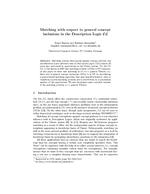Matching with respect to general concept inclusions in the Description Logic $\mathcal{EL}$
Aus International Center for Computational Logic
Matching with respect to general concept inclusions in the Description Logic $\mathcal{EL}$
Franz BaaderFranz Baader, Barbara MorawskaBarbara Morawska
Franz Baader, Barbara Morawska
Matching with respect to general concept inclusions in the Description Logic $\mathcal{EL}$
In Carsten {Lutz} and Michael {Thielscher}, eds., Proceedings of the 37th German Conference on Artificial Intelligence (KI'14), volume 8736 of Lecture Notes in Artificial Intelligence, 135--146, 2014. Springer
Matching with respect to general concept inclusions in the Description Logic $\mathcal{EL}$
In Carsten {Lutz} and Michael {Thielscher}, eds., Proceedings of the 37th German Conference on Artificial Intelligence (KI'14), volume 8736 of Lecture Notes in Artificial Intelligence, 135--146, 2014. Springer
- KurzfassungAbstract
Matching concept descriptions against concept patterns was introduced as a new inference task in Description Logics (DLs) almost 20 years ago, motivated by applications in the Classic system. For the DL EL, it was shown in 2000 that matching without a TBox is NP-complete. In this paper we show that matching in EL w.r.t. general TBoxes (i.e., finite sets of general concept inclusions, GCIs) is in NP by introducing a goal-oriented matching algorithm that uses non-deterministic rules to transform a given matching problem into a solved form by a polynomial number of rule applications. We also investigate some tractable variants of the matching problem w.r.t. general TBoxes. - Forschungsgruppe:Research Group: AutomatentheorieAutomata Theory
@inproceedings{ BaMo-KI2014,
author = {Franz {Baader} and Barbara {Morawska}},
booktitle = {Proceedings of the 37th German Conference on Artificial Intelligence (KI'14)},
editor = {Carsten {Lutz} and Michael {Thielscher}},
pages = {135--146},
publisher = {Springer-Verlag},
series = {Lecture Notes in Artificial Intelligence},
title = {Matching with respect to general concept inclusions in the Description Logic $\mathcal{EL}$},
volume = {8736},
year = {2014},
}
